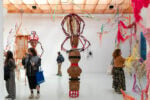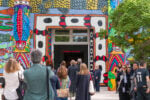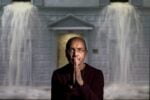Richard Loskot / Cristian Avram
.jpg)
Boccanera Gallery, Trento, ha il piacere di presentare la seconda mostra personale di Richard Loskot (Most, CZ nel 1984), Cosmology Model, in contemporanea con The Place we call Home, il progetto di Cristian Avram (Cluj-Napoca, RO nel 1994), nello spazio Boccanera Project Room.
Comunicato stampa
Boccanera Gallery, Trento, ha il piacere di presentare la seconda mostra personale di Richard Loskot (Most, CZ nel 1984), Cosmology Model, in contemporanea con The Place we call Home, il progetto di Cristian Avram (Cluj-Napoca, RO nel 1994), nello spazio Boccanera Project Room.
Recentemente Boccanera Gallery ha ampliato la sede di Trento e nei suoi 300 metri quadri ospiterà i progetti di due giovani artisti dell’Est Europa confluenti in un comune denominatore: lo spazio.
Le opere dei due artisti indagano in maniera opposta sulle molteplici influenze nel rapporto tra uomo e spazio: Cristian Avram, nelle sue opere a olio su tela, esplora il microcosmo delle pareti domestiche della sua casa-studio nelle campagne nei dintorni della città rumena di Cluj-Napoca, e Richard Loskot, attraverso la creazione di apparati tecnologici rudimentali, macchinari assemblati con parti di oggetti di uso comune e pezzi di mobilio, guarda alla grandezza e ai misteri del Cosmo.
Lo spazio non è solo la proiezione di un soggetto, un involucro, un disegno ma è anche il deposito di tutte le nevrosi e le fobie della società che lo circonda. In questo senso lo spazio non è vuoto ma pieno di oggetti disturbanti. L’arte ha la capacità di rappresentare lo spazio nella sua distorsione, modificando la maniera tradizionale in cui è stato storicamente concepito.
Il progetto di Richard Loskot, Cosmology Model, verte sulla contraddizione tra l'avanzamento tecnologico e suoi stessi limiti.
Partendo dal concetto di reprocità, Richard riflette sul rapporto tra Uomo e Universo e su come l'ignoto scateni nella mente umana una serie di quesiti esistenziali ai quali, nonostante l'apporto delle più avanzate intelligenze artificiali, non è possibile rispondere.
Loskot s’interroga su concetti apparentemente semplici: cos'è un colore, cos'è il vuoto, come si comporta il caso.
Cosmology Model è un viaggio che parte dallo scheletro scarno della macchina e si muove verso alla percezione enigmatica interiore del concetto d’infinito.
I lavori di Loskot sono modelli che restituiscono immagini con l'ausilio di apparati posti strategicamente tra lo spettatore e l'oggetto, trasformando i luoghi riprodotti dalla macchina in spazi sensibili. L'opera quindi ha sempre due tempi di lettura, quella d’insieme e quella innescata dalla presenza del fruitore.
Costruire questi oggetti tramite l'assemblaggio di meccanismi recuperati da oggetti comuni, ha come fine ultimo quello di riflettere sul microcosmo che circonda l'essere umano nella quotidianità.
Il mondo è ricoperto di una costellazione di oggetti capaci di svelarci l'essenza della vita, se solo si cerca con attenzione.
In The Place we call Home, attraverso le sue pitture a olio su tela, Cristian Avram esplora la collisione tra mondo interno e mondo esterno, e come quest’ossimoro può dare origine a stati di coscienza superiore.
Cristian come Richard parte da concetti semplici: come la ricerca della bellezza della quotidianità permetta agli esseri umani di chiamare un luogo casa.
Cristian Avram recentemente si è trasferito dalla città a un remoto complesso di casa-studio d'artista nelle campagne di Cluj Napoca.
Nella solitudine di quel luogo, durante il suo primo inverno passato vivendo in isolamento, ha osservato come lo spazio da impervio stabile post-soviet si sia trasformato nella sua casa ed ha ritratto la trasformazione attraverso i residui della presenza umana nello spazio.
Il lavoro di Avram, sempre concentrato sul suo vissuto personale, sviluppa il senso del tempo puro, non databile.
Con un’analisi sull’estetica dello spazio, tenta di sondare le possibili alterazioni dell’ambiente, dal tangibile all’immateriale, alla dimensione privata a quella sociale.
Il giovane pittore rumeno quindi cerca di ricomporre nella composizione delle sue opere una gerarchia estetica, ritraendo il disordine organizzato degli spazi usati dall’uomo in sua assenza.
L'esistenza dell'essere umano è tangibile ma l'astrazione del mezzo della pittura restituisce la dimensione animifica propria degli ambienti ritratti, creando un luogo dell’ammina.
Lo spazio espande nelle sue dimensioni fisiche verso l'infinito dello spirito.
Entrambe le mostre convergono quindi sulla riflessione della reciprocità tra microcosmo e macrocosmo e come la dimensione sensibile della percezione dello spazio renda le sue coordinate illeggibili.
Richard Loskot nasce a Most (CZ) nel 1984. Vive e lavora ad Usti nad Labem (CZ). Studia presso la facoltà di architettura dell'università di Liberec e all'Istituto di Belle Arti di Monaco. Ha esposto in Germania, UK, Romania, Repubblica Ceca e Repubblica Slovacca. Nel 2012, nel 2014 e nel 2017 è stato tra i cinque finalisti del premio piu` prestigioso della Repubblica Ceca Jindřich Chalupecký con menzione speciale nel 2012. Nei mesi di gennaio e febbraio 2014 ha svolto la residenza all’International Studio & Curatorial Program di New York. Nel settembre 2014 ha partecipato alla mostra collettiva Europa, Europa curata da Hans Ulrich Obrist, Thomas Boutoux, Gunnar B. Kvaran presso l'Astrup Fearnley Museet di Oslo.
Cristian Avram nasce ad Alba-Iulia, RO nel 1994. E’ studente al primo anno del master in pittura all'Università di Arte e Design di Cluj-Napoca(RO).
Mostre selezionate: Talking 'bout my generation, mostre collettiva, Plan B Cluj-Napoca (2018), Bridges, mostre collettiva, Boccanera Gallery, Milano (2018); Starpoint Prize 2017, mostra collettiva, Victoria Art Center, Bucarest (2017); Cutting Edge III, mostra collettiva, Museum of Art Cluj-Napoca, (2016).
EN
Boccanera Gallery, Trento, is pleased to present the second solo exhibition by Richard Loskot (Most, CZ in 1984), Cosmology Model, at the Main Gallery space, and The Place we call Home, Cristian Avram's project (Cluj-Napoca, RO in 1994), at the Project Room space.
Recently, Boccanera Gallery has developed its Trentine headquarters, and in its 300 square meters will be hosting the projects of two young Eastern European artists focused on a shared interest: space.
The works of both artists investigate the relationship between man and space.
In his oil paintings on canvas Cristian Avram explores the microcosm of the domestic surroundings of his home-studio in the countryside of the Romanian city of Cluj-Napoca. Richard Loskot looks at the greatness and the mysteries of the Cosmos building rudimentary devices, machines assembled with parts of everyday objects, obsolete technology and pieces of furniture.
Space is not only the extension of a subject, a box, a design but it is also the storage of neuroses and phobias of the surroundings' society. In this sense, space is not empty but full of unsettled objects. Art can represent space in its distortion, modifying the traditional way in which it has been historically perceived.
Cosmology Model by Richard Loskot focuses on the contradictions of the limits of advanced technology.
Starting from the concept of reciprocity, Richard envisions the relationship between Man and the Universe and how the unknown unleashes a series of enigmatic questions about existence in which, despite the contribution of the most advanced artificial intelligence, they remain incomprehensible.
Loskot reflects on likely banal concepts: what is a color, what is emptiness, how does a circumstance work?
Cosmology Model is a journey that starts with the bone structure of the machine and moves towards the inner perception of the enigma of the infinite.
Loskot's works are models that construct images only visible through a third piece of equipment placed strategically between the viewer and the object with the aim of translating the space reproduced by the machine in the space of consciousness. Therefore, the work always has two different stages of analysis: the whole and the one triggered by the presence of an audience.
Through the assembly of mechanisms recovered from ordinary objects, Loskot reflects on the everyday life's microcosm surroundings the human beings.
The world is coated with an unequivocal constellation of objects capable of unveiling the essence of life.
In The Place we call Home, in his oil paintings, Cristian Avram explores the collision between the inner world and the outer world, and how this oxymoron can rise states of higher consciousness.
As with Richard, Cristian starts his research from a simple concept: what are the factors that can bring a human being to call a place home and how beauty can be the key to it.
Cristian Avram recently moved from the city to a remote artist-studio complex in the countryside of Cluj Napoca.
During his first winter spent living in solitude and isolation he experienced how the post-Soviet impervious building turned into his home, portraying the transformation through the ghostly presence of humans activities in the space.
Avram's work focuses on his personal experience translating it into timeless images.
He explores the possible alterations of the environment capturing the moment between the tangible to the immaterial, from the personal matter to the public life.
The young Romanian painter reconstructs in his works an aesthetic hierarchy, portraying the organized manmade disorder of spaces occupied by human beings in its absence.
The existence of being is tangible, but the abstraction of the medium creates a place of the soul in the subject of the artwork.
The physical proportions of the space expand towards a spiritual dimension.
Both exhibitions reflection on the interchange between microcosm and macrocosm and how the coordinates of space are illegible applying variables related to irrational thought.
Richard Loskot was born in Most (CZ) in 1984, lives and works in Usti nad Labem (CZ). He studied in the faculty of Art and Architecture at the University of Liberec as well as in the Munich School of Fine Art. He has exhibited in Germany, the UK, and in Romania, as well as in the Czech Republic and Slovakia. In 2012 and 2014 he was one of the five finalists for the most prestigious prize in Czech Republic Jindřich Chalupecký prize with a special mention. In January and February 2014 participated in a residence in the International Studio & Curatorial Program of New York. In September 2104 he did a group exhibition Europe, Europe curated by Hans Ulrich Obrist, Thomas Boutoux, Gunnar B. Kvaran at Astrup Fearnley Museet in Oslo.
Currently, he is part of two group shows Nature. Arte ed Ecologia, curated by Margherita de Pilati, in Galleria Civica in Trento and Arthouse Lapidarium, curated by Lenka Lindaurová at the National Museum in Prague.
Cristian Avram, born ad Alba-Iulia, RO in 1994, is attending the first year of the Masters in Painting at the Cluj-Napoca University of Art and Design (RO).
Selected exhibitions: Talking 'bout my generation, group exhibition, Plan B Cluj-Napoca; Bridges, group exhibition, Boccanera Gallery, Milan (2018); Starpoint Prize 2017, group exhibition, Victoria Art Center, Bucharest (2017); Cutting Edge III, group exhibition, Museum of Art Cluj-Napoca, (2016).



